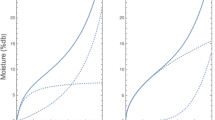Abstract
The objectives of this study were to investigate the effects of manufacturing parameters on the moisture sorption isotherms of some tablet formulations and to predict the moisture isotherms of the final formulations using polynomial equations. Three tablet formulations including a placebo and 2 drug products were prepared through wet granulation, drying, compression, and coating processes. Equilibrium moisture content of excipients and granules at 25°C with different relative humidities were determined using a dynamic moisture sorption microbalance, while such data for tablets were determined using desiccators. Moisture sorption isotherms were expressed in polynomial equations. Excipient isotherms were used to predict the moisture sorption isotherms of the 3 tablet products. Results showed that different physical properties of granules and tablets, such as particle size distribution, density, and porosity resulting from different granulation and compression conditions did not have significant effect on the moisture isotherms of the materials. Changing coating materials from a powder mixture to a film also did not change the moisture sorption characteristics significantly. The predicted moisture sorption isotherms of the formulations agreed well with the experimental results. These results show that moisture isotherms of solid pharmaceutical products manufactured with conventional processes may be predicted using the isotherms of excipients, and polynomial equations may be used as a tool for the prediction of moisture isotherms.
Similar content being viewed by others
References
Kontny MJ, Mulski CA. Gelatin capsule brittleness as a function of relative humidity at room temperature.Int J Pharm. 1989;54:79–85.
Chang RK, Raghavan KS, Hussain MA. A study on gelatin capsule brittleness: Moisture transfer between the capsule shell and its content.J Pharm Sci. 1998;87:556–558.
Kontny MJ, Koppenol S, Graham ET. Use of the sorption-desorption moisture transfer model to assess the utility of a desiccant in a solid product.Int J Pharm. 1992;84:261–271.
Chen Y, Li Y. A new model for predicting moisture uptake by packaged solid pharmaceuticals.Int J Pharm. 2003;255:217–225.
Zografi G, Grandolfi GP, Kontny MJ, Mendenhall DW. Prediction of moisture transfer in mixtures of solids: transfer via the vapor phase.Int J Pharm. 1988;42:77–88.
Badawy SIF, Gawronski AJ, Alvarez FJ. Application of sorption-desorption moisture transfer modeling to the study of chemical stability of a moisture sensitive drug product in different packaging configurations.Int J Pharm. 2001;223:1–13.
Dalton CR, Hancock BC. Processing and storage effects on water vapor sorption by some model pharmaceutical solid dosage formulations.Int J Pharm. 1997;156:143–151.
Nyqvist H. Saturated salt solutions for maintaining specified relative humidities.Int J Pharm Tech & Prod Mfr. 1983;4:47–48.
Greenspan L. Humidity fixed points of binary saturated aqueous solutions.J Res Nat Bur Stand. 1977;1:89–96.
USP 25.The United States Pharmacopeia. Rockville, MD: United States Pharmacopeial Convention; 2002:1981–1982.
USP 25.The United States Pharmacopeia. Rockville, MD: United States Pharmacopeial Convention; 2002;2009–2010.
Ahlneck C, Zografi G. The molecular basis of moisture effects on the physical and chemical stability of drugs in the solid state.Int J Pharm. 1990;62:87–95.
Author information
Authors and Affiliations
Corresponding author
Rights and permissions
About this article
Cite this article
Li, Y., Sanzgiri, Y.D. & Chen, Y. A study on moisture isotherms of formulations: the Use of polynomial equations to predict the moisture isotherms of tablet products. AAPS PharmSciTech 4, 59 (2003). https://doi.org/10.1208/pt040459
Received:
Accepted:
DOI: https://doi.org/10.1208/pt040459




